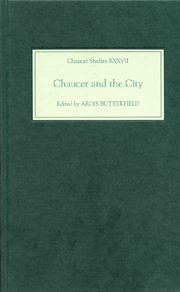Book contents
- Frontmatter
- Contents
- List of Illustrations
- Dedication
- Preface
- List of Contributors
- Abbreviations
- Map
- INTRODUCTION
- LOCATIONS
- 2 Greater London
- 3 The Production of Space in Chaucer's London
- 4 Chaucer's Poetics of Dwelling in Troilus and Criseyde
- COMMUNITIES
- INSTITUTIONS
- AFTERLIVES
- Bibliography
- Index
- CHAUCER STUDIES
3 - The Production of Space in Chaucer's London
from LOCATIONS
Published online by Cambridge University Press: 05 February 2013
- Frontmatter
- Contents
- List of Illustrations
- Dedication
- Preface
- List of Contributors
- Abbreviations
- Map
- INTRODUCTION
- LOCATIONS
- 2 Greater London
- 3 The Production of Space in Chaucer's London
- 4 Chaucer's Poetics of Dwelling in Troilus and Criseyde
- COMMUNITIES
- INSTITUTIONS
- AFTERLIVES
- Bibliography
- Index
- CHAUCER STUDIES
Summary
London Lives
Wordsworth's 1807 sonnet ‘Composed upon Westminster Bridge’ imagines London as a colossal human being, slumbering at dawn and wearing the beauty of the morning ‘like a garment’, its ‘mighty heart … lying still’. In Master Humphrey's Clock (1840–41), Charles Dickens, one of the greatest recorders of nineteenth-century London, addresses that very heart:
Heart of London, there is a moral in thy every stroke! as I look on at thy indomitable working, which neither death, nor press of life, nor grief, nor gladness out of doors will influence one jot, I seem to hear a voice within thee which sinks into my heart, bidding me, as I elbow my way among the crowd, to have some thought for the meanest wretch that passes, and, being a man, to turn away with scorn and pride from none that wears the human shape.
For Dickens, London is a hybrid form, both human and mechanical: impervious as a machine to the vagaries of nature, yet urging the author, man to man, to feel sympathy for its inhabitants. And the 1999 Granta anthology London: The Lives of the City, as its ambiguous title suggests, celebrates not only the lives of those who live in the city but also the lives that the city leads, as if London were a person.
- Type
- Chapter
- Information
- Chaucer and the City , pp. 41 - 56Publisher: Boydell & BrewerPrint publication year: 2006



